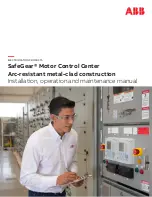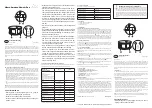
I N S TA L L AT I O N , O P ER AT I O N A N D M A I N T EN A N C E M A N UA L
10
Testing
Control circuit checkout
With the equipment raised, assembled and connected, perform the following process:
1. Remove packing and shipping materials.
2. Make sure that all internal parts are clean and dry. If moisture is present, blow dry with warm air.
3. Remove any shipping blocks from relays.
4. Check for damaged insulation by applying potential tests to the primary bus. Apply potential tests phase-to-
phase and phase to ground in accordance with “Field Test” values.
5. When the main circuit is de-energized and grounded, check the continuity of all circuits after installing the
contactors. After this, energize the control source and operate the equipment. The indicating instruments verify
the continuity of current transformer circuits and the energizing of the main circuit.
The preferred method to check the control circuit is to furnish a separate temporary control power source of
the required control voltage rating. The temporary source must have a properly coordinated backup
protective device in the circuit. Set the device to clear any faults that might occur. Initially all contactors
should be racked out (“DISCONN.” position) and the main circuit deenergized and grounded. When AC control
power is from control power transformers in the MCC, remove all fuses in the transformer circuits.
—
Testing and final inspection
Disconnect the primary power source during testing. Do not exceed the listed voltage class of the equipment
during testing. Disconnect shunt connected coils such as potential transformer. Do not test sensors in solid
state and relay with high voltage. Disconnect them before applying voltage.
The contantor or cutout device of the local control power circuit must be opened when is used a separated
control power source.
DANGER
DANGER
Rated control voltages
Factory test
0 V to 600 V
2 x nominal v1000 V plus
601 V to 7200 V
2.25 x nominal v2000 V plus
Test voltages for dielectric voltage-withstand test














































